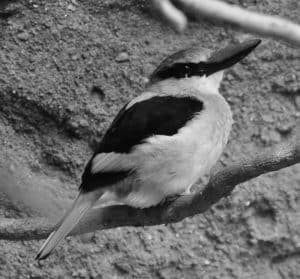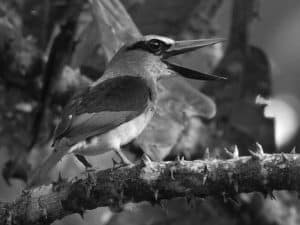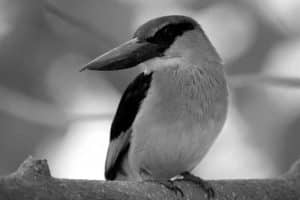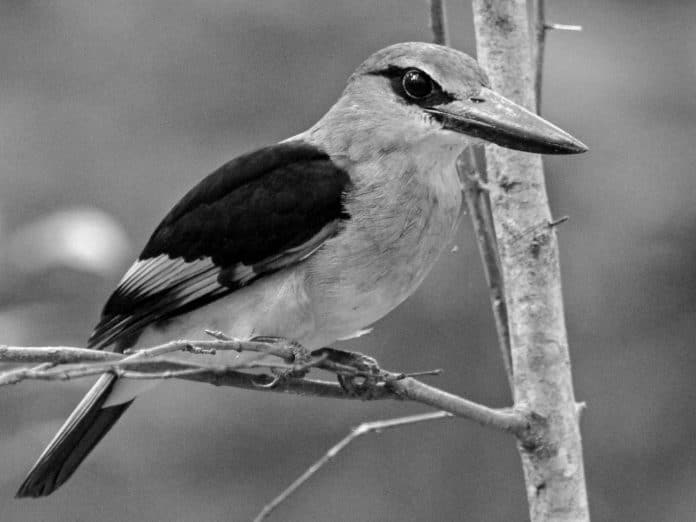Introduction to the Blue-Breasted Kingfisher
The Blue-Breasted Kingfisher, scientifically known as Halcyon malimbica, is a stunning bird species that graces the Tanzanian mangroves with its vibrant sky-blue plumage and melodious calls. As a member of the kingfisher family, it possesses a unique charm that captivates birdwatchers and nature enthusiasts from around the world. With its distinctive appearance and behavior, the Blue-Breasted Kingfisher in Tanzania holds a special place in the rich biodiversity of Tanzania’s coastal areas, making it a sought-after sighting for wildlife enthusiasts and photographers.

The Blue-Breasted Kingfisher is renowned for its striking appearance, characterized by a vibrant blue breast, contrasting with its white throat and underparts. Its back and wings exhibit a deep shade of cobalt blue, creating a mesmerizing spectacle as it flits through the lush greenery of the mangroves. The species is further distinguished by its long, sturdy bill, perfectly adapted for capturing its aquatic prey. With its regal presence and distinctive features, the Blue-Breasted Kingfisher embodies the natural beauty and diversity of Tanzania’s avian inhabitants.
Tanzania’s coastal region, particularly the mangroves and estuaries, serves as the primary habitat for the Blue-Breasted Kingfisher. These intricate ecosystems provide the ideal environment for the species to thrive, offering an abundance of food sources and nesting sites. The mangroves’ proximity to water bodies and their rich biodiversity create a perfect haven for the kingfishers, allowing them to carry out their natural behaviors while contributing to the ecological balance of the region. Understanding the habitat of the Blue-Breasted Kingfisher is essential for appreciating its significance within the Tanzanian ecosystem and for maximizing the chances of encountering these majestic birds in the wild.
Habitat of the Blue-Breasted Kingfisher in Tanzania
The Blue-Breasted Kingfisher’s habitat in Tanzania consists primarily of the coastal mangroves and estuaries that line the shores of the Indian Ocean. These unique ecosystems are characterized by a complex network of tidal channels, mudflats, and dense mangrove forests, creating a diverse and dynamic environment that supports a wide array of flora and fauna. The kingfishers are particularly drawn to the water’s edge, where they can hunt for their aquatic prey and establish their nesting territories.
Within the mangroves, the Blue-Breasted Kingfishers seek out suitable perches from which they can survey the water below for fish, crustaceans, and other small aquatic creatures. Their keen eyesight and swift diving abilities make them adept hunters, allowing them to plunge into the water with remarkable precision to capture their prey. Additionally, the dense foliage and intricate root systems of the mangroves provide the kingfishers with secluded nest sites, offering protection and seclusion for breeding and raising their young.
The intricate relationship between the Blue-Breasted Kingfisher and its mangrove habitat underscores the importance of conserving these coastal ecosystems. By safeguarding the mangroves and preserving the delicate balance of this unique environment, conservation efforts can ensure the continued presence of the kingfishers and other wildlife that depend on these vital coastal habitats.
Behavior and Diet of the Blue-Breasted Kingfisher
The Blue-Breasted Kingfisher’s behavior is a fascinating display of agility, precision, and adaptability, reflecting its specialized adaptations for life in the mangroves. These birds are known for their distinctive hunting techniques, which involve perching near the water’s edge and scanning for potential prey. Once a suitable target is spotted, the kingfisher plunges into the water with remarkable speed, using its sharp bill to grasp its catch before returning to a perch to consume it.
In addition to their remarkable fishing abilities, Blue-Breasted Kingfishers are also vocal and territorial birds, emitting a series of melodious calls that echo through the mangroves. These calls serve as a means of communication between individuals and are often used to establish and defend breeding territories. During the breeding season, the kingfishers engage in elaborate courtship displays, further showcasing their vibrant plumage and behavioral repertoire.
The diet of the Blue-Breasted Kingfisher consists primarily of small fish, crustaceans, and aquatic insects, all of which are abundant in the rich coastal waters of Tanzania. Their reliance on these aquatic resources underscores the interconnectedness of the kingfishers with their mangrove habitat, highlighting the significance of preserving these delicate ecosystems for the species’ continued survival.
Conservation Status of the Blue-Breasted Kingfisher in Tanzania

In Tanzania, the Blue-Breasted Kingfisher is recognized as a species of least concern according to the International Union for Conservation of Nature (IUCN) Red List. However, despite its current stable status, the kingfisher faces potential threats from habitat loss, pollution, and disturbances to its coastal habitats. The preservation of the mangroves and estuaries is crucial for safeguarding the kingfishers and the diverse array of wildlife that depend on these vital ecosystems.
Conservation efforts aimed at protecting the Blue-Breasted Kingfisher and its habitat involve a combination of habitat preservation, environmental education, and sustainable management practices. By raising awareness about the importance of coastal ecosystems and implementing measures to minimize human impact on these fragile environments, conservationists can help secure a brighter future for the kingfishers and the intricate web of life that they are a part of.
Best Locations for Birdwatching the Blue-Breasted Kingfisher in Tanzania
Tanzania’s coastal region offers a multitude of prime birdwatching locations for observing the Blue-Breasted Kingfisher in its natural habitat. The mangrove-lined estuaries and river mouths provide ideal settings for encountering these majestic birds, offering opportunities for birdwatchers to witness their hunting prowess and vibrant plumage.
One of the premier locations for birdwatching the Blue-Breasted Kingfisher is the Rufiji River Delta, a sprawling network of mangrove-lined channels and brackish waterways that teem with avian life. Here, visitors can embark on boat safaris and guided excursions to explore the intricate waterways and witness the kingfishers in action as they dive and dart through the tangled roots of the mangroves.
Another noteworthy birdwatching destination is the Kilwa District, where mangrove forests and coastal lagoons provide a haven for the kingfishers and an array of other bird species. Guided birdwatching tours in this region offer opportunities to observe the kingfishers’ behaviors and interactions within their natural environment, providing a memorable and immersive wildlife experience.
Tips for Spotting the Blue-Breasted Kingfisher in Tanzanian Mangroves
Spotting the elusive Blue-Breasted Kingfisher in the Tanzanian mangroves requires patience, keen observation, and an understanding of its habitat and behavior. When venturing into the coastal ecosystems where these birds reside, it is essential to adopt a respectful and unobtrusive approach to avoid disturbing the kingfishers and other wildlife. By following these tips, birdwatchers can enhance their chances of encountering the Blue-Breasted Kingfisher in its natural environment.
- Choose the Right Time: Early morning and late afternoon are prime times for birdwatching, as the kingfishers are often more active during these periods. Their vibrant plumage is also accentuated by the soft, golden light, enhancing the photographic opportunities.
- Be Mindful of Noise: When approaching the mangroves, maintain a quiet and unobtrusive demeanor to minimize disturbances to the kingfishers and other wildlife. Silence your electronic devices and refrain from making loud noises that could startle the birds.
- Utilize Binoculars and Spotting Scopes: Equip yourself with high-quality binoculars and spotting scopes to enhance your ability to observe the kingfishers from a distance without intruding on their natural behaviors. These optical tools can provide detailed views of the birds’ activities without causing disruption.
By adhering to these tips and exercising sensitivity to the natural surroundings, birdwatchers can heighten their chances of encountering the enchanting Blue-Breasted Kingfisher in the Tanzanian mangroves, fostering a deeper appreciation for these remarkable avian inhabitants.
Photography Tips for Capturing the Blue-Breasted Kingfisher

Photographing the Blue-Breasted Kingfisher in Tanzania’s mangroves presents a rewarding yet challenging endeavor, requiring a blend of technical skill, patience, and an understanding of the kingfishers’ behaviors. With its vibrant plumage and dynamic movements, the kingfisher offers captivating photographic opportunities for wildlife photographers seeking to capture its beauty in its natural habitat.
When photographing the Blue-Breasted Kingfisher, consider the following tips to enhance your chances of capturing compelling images of these magnificent birds:
- Study the Behavior: Observe the kingfishers’ hunting and perching behaviors to anticipate their movements and identify optimal vantage points for photography. Understanding their patterns can help you position yourself for the best shot.
- Utilize Natural Light: Leverage the soft, natural light of the mangroves to illuminate the kingfishers’ plumage, capturing the vivid hues of their sky-blue feathers. Consider the angle of the sunlight to enhance the visual impact of your photographs.
- Exercise Patience: Be prepared to spend time observing the kingfishers and waiting for opportune moments to capture their activities. Patience is key when seeking to photograph these elusive and agile birds in their natural environment.
By applying these photography tips and maintaining a respectful approach to wildlife, photographers can create striking images that convey the beauty and vitality of the Blue-Breasted Kingfisher in Tanzania’s coastal mangroves.
The Role of Blue-Breasted Kingfishers in Tanzanian Ecosystems
The Blue-Breasted Kingfishers play a vital role in the ecological balance of Tanzania’s coastal ecosystems, contributing to the regulation of aquatic populations and the dynamic interconnectedness of the mangrove habitats. As piscivorous birds, they help control fish and crustacean populations, exerting a top-down influence on the aquatic food web and contributing to the overall health and stability of the coastal environment.
Moreover, the kingfishers’ nesting activities and foraging behaviors contribute to the dispersal of seeds and the cycling of nutrients within the mangroves, further shaping the structure and function of these unique ecosystems. By participating in these ecological processes, the Blue-Breasted Kingfishers underscore their significance as integral components of Tanzania’s coastal landscapes, highlighting the intricate web of relationships that sustains the region’s biodiversity.
Understanding the ecological contributions of the Blue-Breasted Kingfishers is essential for fostering a comprehensive appreciation of their role within Tanzanian ecosystems and for advocating their conservation within the broader context of coastal habitat preservation.
Efforts and Organizations for Blue-Breasted Kingfisher Conservation
A number of organizations and initiatives are dedicated to the conservation of the Blue-Breasted Kingfisher and its coastal habitats in Tanzania. These efforts aim to address the various threats facing the kingfishers and work towards ensuring the long-term survival of this captivating species in the wild.
One such organization is the Tanzania Forest Conservation Group (TFCG), which focuses on safeguarding the country’s diverse ecosystems, including the mangrove habitats that are critical for the Blue-Breasted Kingfishers. Through research, advocacy, and community engagement, the TFCG strives to protect and restore coastal environments, promoting sustainable management practices and raising awareness about the importance of conserving these vital ecosystems.
Additionally, collaborative initiatives involving local communities, governmental agencies, and conservation stakeholders are instrumental in addressing the complex challenges of coastal habitat conservation. By fostering partnerships and implementing integrated conservation strategies, these collaborative efforts contribute to the preservation of the Blue-Breasted Kingfisher’s habitat and the broader conservation of Tanzania’s coastal biodiversity.
Conclusion
The Blue-Breasted Kingfisher stands as a symbol of the natural splendor and ecological richness found within Tanzania’s coastal mangroves. With its resplendent sky-blue plumage, distinctive hunting prowess, and vital ecological contributions, the kingfisher embodies the vibrant tapestry of life that thrives within these unique coastal habitats. By understanding the behavior, habitat, and conservation status of the Blue-Breasted Kingfisher, wildlife enthusiasts can gain a deeper appreciation for the species and contribute to its preservation for future generations to admire.
As visitors and conservationists alike venture into the mangroves of Tanzania, they are presented with the opportunity to witness the majesty of these captivating birds and engage in efforts to protect their vital ecosystems. Through responsible ecotourism, wildlife observation, and collaborative conservation initiatives, individuals can play a role in safeguarding the Blue-Breasted Kingfisher and the diverse array of wildlife that call Tanzania’s coastal regions home. By celebrating the presence of the kingfishers and advocating for the preservation of their habitats, we can ensure that these sky-blue icons continue to grace the Tanzanian mangroves, enriching the natural heritage of this remarkable East African nation.


































